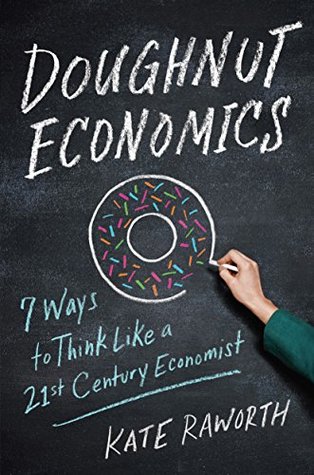More on this book
Community
Kindle Notes & Highlights
by
Kate Raworth
Read between
April 28 - April 29, 2021
Buckminster Fuller once said, ‘You never change things by fighting the existing reality. To change something, build a new model that makes the existing model obsolete.’
What if we started economics not with its long-established theories but with humanity’s long-term goals, and then sought out the economic thinking that would enable us to achieve them?
Pre-analytic vision. Worldview. Paradigm. Frame. These are cousin concepts. What matters more than the one you choose to use is to realise that you have one in the first place, because then you have the power to question and change it.
it is absolutely essential to have a compelling alternative frame if the old one is ever to be debunked. Simply rebutting the dominant frame will, ironically, only serve to reinforce it. And without an alternative to offer, there is little chance of entering, let alone winning, the battle of ideas.
Today we have economies that need to grow, whether or not they make us thrive; what we need are economies that make us thrive, whether or not they grow.
Five factors certainly play key roles: population, distribution, aspiration, technology and governance.
As economist Tim Jackson deftly put it, we are ‘persuaded to spend money we don’t have on things we don’t need to make impressions that won’t last on people we don’t care about’.
First, rather than narrowly self-interested, we are social and reciprocating. Second, in place of fixed preferences, we have fluid values. Third, instead of isolated, we are interdependent. Fourth, rather than calculate, we usually approximate. And fifth, far from having dominion over nature, we are deeply embedded in the web of life.
Today’s economy is divisive and degenerative by default. Tomorrow’s economy must be distributive and regenerative by design.
Instead of focusing on redistributing income alone, they will also seek to redistribute wealth—be it the power to control land, money creation, enterprise, technology or knowledge—and will harness the market, the commons and the state alike to make it happen. Rather than wait for top-down reform, they will work with bottom-up networks that are already driving a revolution in redistribution.
In California, the company Newlight Technologies is capturing methane emissions from dairy cows, turning them into bioplastic and making products—such as bottles and office chairs—which have been independently verified as carbon-negative, sequestering greenhouse gas emissions across their entire life cycle.29 In the arid coastal lands of South Australia, Sundrop Farms is using seawater and sunlight to grow tomatoes and capsicums. Its state-of-the-art greenhouses harness solar energy to desalinate the saltwater, create heat and generate electricity, all used to grow the crops. ‘We’re not just
...more
The developer’s first response? ‘But why should I provide clean air for the rest of the city?’ It’s an unsurprising question, indicative of the near ubiquitous business mindset that has arisen from the design of contemporary capitalism. And that design is the opposite of generous. It is focused instead on creating just one form of value—financial—for just one interest group: shareholders. While regenerative designers now ask themselves, ‘how many diverse benefits can we layer into this?’, mainstream business still asks itself, ‘how much financial value can we extract from this?’ Of course
...more
Regenerative industrial design can only be fully realised if it is underpinned by regenerative economic design.
The keep-on-flying passengers: economic growth is still necessary—and so it must be possible. The prepare-for-landing passengers: economic growth is no longer possible—and so it cannot be necessary.
We have an economy that needs to grow, whether or not it makes us thrive. We need an economy that makes us thrive, whether or not it grows.


